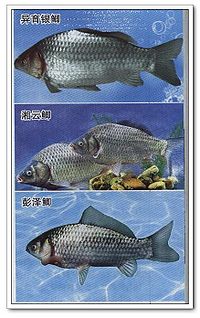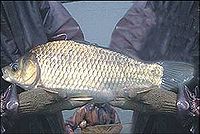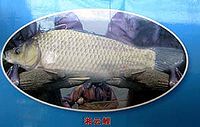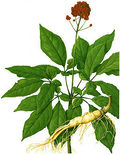鲫鱼
| A+医学百科 >> 药品百科 >> 中药百科 >> 鲫鱼 | 中药图典 |
| 鲫鱼 Jì Yú |
|
|---|---|
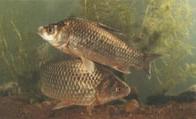 |
|
| 别名 | 鲫、鲋、鰶、鲫瓜子 |
| 功效作用 | 滋补,利水。主治脾胃虚弱,胃痛呕吐,水肿,走马牙疳,牙痛等。 |
| 英文名 | Goldfish |
| 始载于 | 《名医别录》 |
| 毒性 | 无毒 |
| 归经 | 胃经、脾经、大肠经 |
| 药性 | 平 |
| 药味 | 甘 |
目录 |
基本信息
jì yú
鲫鱼,又称鲋鱼,鲫瓜子,鲫皮子。肚米鱼
鲫鱼(鲤科)Carassius auratus
[地方名]草鱼板子、喜头鱼、鲫瓜子、鲋鱼、鲫拐子、朝鱼、刀子鱼、鲫壳子、金鱼(江苏金坛)。
[形态特征]一般体长15~20厘米。体侧扁而高,体较厚,腹部圆。头短小,吻钝。无须。鳃耙长,鳃丝细长。下咽齿一行,扁片形。鳞片大。侧线微弯。背鳍长,外缘较平直。背鳍、臀鳍第3根硬刺较强,后缘有锯齿。胸鳍末端可达腹鳍起点。尾鳍深叉形。一般体背面灰黑色,腹面银灰色,各鳍条灰白色。因生长水域不同,体色深浅有差异。
腹部背部是白黑的,背部是黑的.天敌从水上方往下看,由于黑色的鱼背和河底淤泥同色,故难被发现;天敌若从水下方往上看,由于白色鱼肚和天颜色差不多,故也难被发现;经常看到有些文章里形容清晨时分“东方泛起了鱼肚白”,就是这个道理。属于保护色。
[产地、产季]全国各地水域常年均有生产,以2~4月份和8~12月份的鲫鱼最肥美。鲫鱼属鲤形目、鲤科、鲫属。江苏、浙江一带称河鲫鱼,东北称鲫瓜子,湖北称洗头鱼等。鲫鱼分布很广,除西部高原地区外,广泛分布于全国各地。鲫鱼的适应性非常强,不论是深水或浅水、流水或静水、高温水(32℃)或低温水(0℃)均能生存。即使在pH:9的强碱性水域,盐度高达4.5%的达里湖,仍然能生长繁殖。
鲫鱼的生活习性
鲫鱼是杂食性鱼,但成鱼主要以植物性食料为主。因为植物性饲料在水体中蕴藏丰富,品种每繁多,供采食的面广。维管束水草的茎,叶,芽和果实是鲫鱼爱食之物,在生有菱和藕的高等水生植物的水域,鲫鱼最能获得各种丰富的营养物质。硅藻和一些状藻类也是鲫鱼的食物,小虾,蚯蚓,幼螺,昆虫等它们也很爱吃。
鲫鱼采食时间,依季节不同而不同。春季为采食旺季,昼夜均在不断地采食;夏季采食时间为早,晚和夜间;秋季全天采食;冬季则在中午前后采食。
生活在江河流动水里的鲫鱼,喜欢群集而行。有时顺水,有时逆水,到水草丰茂的浅滩,河湾,沟汊,芦苇丛中寻食,产卵;遇到水流缓慢或静止不动,具有丰富饵料的场所,它们就暂栖息下来。
生活在湖泊和大型水库中的鲫鱼,也是择食而居。尤其在较浅的水生植物丛生地,更是它们的集中地,即使到了冬季,它们贪恋草根,多数也不游到无草的深水处过冬。
生活在小型河流和池塘中的鲫鱼,它们是遇流即行,无流即止,择食而居。冬季多潜入水底深处越冬。
鲫鱼的种类及区分
经过选育的我国地方优良鲫鱼品种
1.高背鲫。高背鲫鱼是上世纪70年代中期在云南滇池及其水系发展起来的一个优势种群,具有个体大、生长快、繁殖力强等特点。因背脊高耸而得名。个体最大3000克,亲水性强,不宜在内地饲养。
2.方正银鲫。方正银鲫原产于黑龙江省方正县双风水库,是一个较好的银鲫品种。方正银鲫背部为黑灰色,体侧和腹部深银白色,最大个体重1.5千克,一般在0.5~1千克左右。
3.彭泽鲫。彭泽鲫是由江西省水产科技人员选育出的一个优良鲫鱼品种,肉味鲜美、含肉率高、营养丰富。体型丰满,易运输,易暂养,易上钩,利于活鱼上市,也是一种生产和游钓兼可发展的鱼类。
4.淇河鲫。淇河鲫因产于河南省北部一条东西流向的山区性河流淇河而得名。淇河常年不结冰,1—2月份时,水温仍在10℃以上,淇河河床两岸水草丛生。优良的生态环境,为淇河鲫的生长、繁殖创造了良好条件。淇河鲫肉嫩味美,据古籍记载,淇河鲫和香稻米、丝蛋一起,是当地的三大贡品。
除上述几种经济价值较大的优良鲫鱼外,还有江苏省六合县的龙池鲫鱼,产于内蒙古海拉尔地区的海拉尔银鲫等等,它们的共同特点是个体大、肉嫩、味美,均深受当地群众所喜爱。
杂交鲫鱼品种
1.异育银鲫。它是以方正银鲫为母本,以兴国红鲤为父本,人工交配所得的子代。异育银鲫比普通鲫鱼生长快2~3倍,生活适应能力强,疾病少,成活率高,既能大水面放养,又能池塘养殖,是非常好的人工繁育品种。
2.杂交鲫鱼。以方正银鲫为母本,太湖野鲤为父本“杂交”而获得的子代。试养表明,它杂交优势明显,具有适应性强、生长快、个体大、食性广、病害少、肉味鲜美等优点,受到生产单位的普遍欢迎。适合于内塘、外荡、河浜以及湖泊围养,是一种经济效益和社会效益都较好的养殖新品种。
引进的鲫鱼品种
目前,中国引进的外来鲫鱼品种只有原产于日本琵琶湖的白鲫,是一种大型鲫鱼。白鲫适应性强,能在不良环境条件下生长和繁殖,对温度、水质变化、低溶氧量等均有较大的忍受力。最大个体在1000克左右。
目前市场上销售的鲫鱼品种较多,如果需要区分野生鲫鱼和养殖鲫鱼可以参照以下方法:首先,看鱼的个体大小。一般养殖的鲫鱼上市规格比较大,尤其是选育和杂交的品种,个头会比较整齐。野生鲫多为大水体捕捞或垂钓而来,个头大小不齐,而且普遍偏小,住往只有养殖鲫鱼的一半大小。其次,看鱼的体型。养殖的鲫鱼一般背脊隆起,身体较宽,而野生鲫鱼身体纺锤型非常明显,头较小。再次,可以看鱼的体色。养殖的鲫鱼体色较浅,侧面以银白色的居多,野生的鲫鱼体色发浅黄,体表光亮。
最新鲫鱼品种
湘云鲫、湘云鲤是由湖南师范大学生命科学院刘筠院士为首的课题组,应用细胞工程技术和有性杂交相结合的方法,经过十多年的潜心研究培育出来的三倍体新型鱼类。与其它鲫鱼和鲤鱼相比,
湘云鲫、湘云鲤具有如下优良特性:
性腺不育 湘云鲫、湘云鲤为异源三倍体新型鱼类,自身不能繁育,可在任何淡水渔业水域进行养殖,不会造成其它鲫、鲤鱼品种资源混杂,也不会出现繁殖过量导致商品鱼质量的下降。
生长速度快 实践表明,湘云鲫生长速度比普通鲫鱼品种快3-5倍,当年鱼苗最大生长个体可达0.75kg;湘云鲤的生长速度比普通鲤鱼快30%-50%,当年鱼苗最大生长个体可达1.7kg。
杂食性,摄食力强,养殖成本低 湘云鲫、湘云鲤为杂食性鱼类,湘云鲫兼有滤食浮游生物的特点,比其他鲤、鲫鱼品种饵料利用率高,同时由于无生殖腺的发育,因此所摄取的营养全
部用于生长。
成活率高,抗病力强 湘云鲤夏花鱼种成活率在90%以上,冬片鱼种成活率可达98%以上。试验表明,湘云鲫、湘云鲤抗病力强,从未发现大规模感染疾病的现象。
耐低温、低氧 湘云鲫、湘云鲤一般不会因为“泛塘”而导致鱼苗大量死亡,适宜高密度池塘精养、网箱及稻田养殖等。湘云鲫、湘云鲤在水温10℃以上即可摄食生长,延长了生长期,在北方地区当年也可养成商品鱼。
体形美观、肉质鲜嫩、营养价值高 湘云鲫、湘云鲤可食部分高出普通鲫、鲤鱼10%-15%,肌间细刺少,肌肉呈味氨基酸含量明显高于日本白鲫和普通鲫、鲤鱼。
经济价值
为我国重要食用鱼类之一。肉质细嫩,肉味甜美,营养价值很高,每百克肉含蛋白质 13克、脂肪 11克,并含有大量的钙、磷、铁等矿物质。鲫鱼药用价值极高,其性味甘、平、温,入胃、肾,具有和中补虚、除湿利水、补虚赢、温胃进食、补中生气之功效,尤其是活鲫鱼汆汤在通乳方面有其他药物不可比拟的作用。鲫鱼汆冬瓜,鲫鱼熬萝卜,不仅味道鲜美,而且可以祛病益寿。条小的鲫鱼可做酥鱼。据分析,每100克鲫鱼肉含蛋白质13克,脂肪1.1克,糖0.1克,硫胺素6.6毫克,核黄素0.07毫克,尼克酸2.4毫克,钙54毫克,磷203毫克,铁2.5毫克。临床实践证明,鲫鱼肉防治动脉硬化、高血压和冠心病均有疗效。
医学认为,鲫鱼性味甘、温。能利水消肿、益气健脾,解毒,下乳。适用于脾胃虚弱,少食乏力,呕吐或腹泻;脾虚水肿,小便不利;气血虚弱,乳汁不通;便血,痔疮出血,臃肿,溃疡等。
《本草纲目》载:“合小豆煮汁服,消水肿:炙油涂,主妇人阴疳诸疮,杀虫止痛;酿五倍子煅研,治下血;酿茗叶煨服,治消渴;酿胡蒜煨研饮服,治膈气。”鱼类 鲤鱼
在寒风萧萧、冷气袭人的冬季,鲫鱼肉肥籽多,味尤鲜美,故民间有“冬鲫夏鲇”之说。我国古医籍《本草经疏》也对鲫鱼有极高评价:“诸鱼中惟此可常食。”
鲫鱼含有丰富的营养成分,如常食,益体补人。它含有蛋白质、脂肪、糖类、无机盐、维生素A、B族维生素、尼克酸等。据测定,每百克黑鲫鱼中,含蛋白质高达20克,仅次于对虾;含脂肪达7克。
据行家讲,鲫鱼下锅前,人们往往忘不了刮鳞抠鳃、剖腹去脏,却很少有去掉其咽喉齿(位于鳃后咽喉部的牙齿)的,这样做出的鲫鱼尤其是清炖、红烧时,其汤汁味道就欠佳,且有的泥味较重。故鲫鱼下锅前最好是去掉其咽喉齿。 寒日食鲫鱼的方法
鲫鱼的养殖
池塘主养鲫鱼要获得高产效益,养殖技术是关键,要注意以下几个方面:
正确分辨鱼种优劣
养殖户在购买鲫鱼鱼种时,应根据主要鲫鱼养殖品种的生物学特征,正确分辨鱼种的伪劣,避免上当受骗蒙受损失。
选好主养品种
目前主养的鲫鱼以异育银鲫、彭泽鲫、湘云鲫为主,其中又以湘云鲫生长速度最快,其次为异育银鲫,最后为彭泽鲫。但彭泽鲫外观优于其它品种,出口商品鲫仍以彭泽鲫鱼为主。
设计好鱼种放养密度
为了降低养殖成本,最好自己培育大规格鱼种。
1.用池塘培育鲫鱼鱼种,每亩放养鲫鱼夏花0.8—1.2万尾可以达到养成规格50---60g的目的。
2.进行鲫鱼成鱼养殖时,鱼种平均规格为50—60g时,每亩放养鲫鱼鱼种1500---1800尾最为理想,养成商品鱼规格可达到350---400g。
确定搭配品种
培育大规格鲫鱼种不要配搭草鱼和鲫鱼,而应选择鲢鱼和鳙鱼,数量应占主养鲫鱼20%左右,鳙鱼则占鲢鱼的10%左右。搭配品种的放养时间不宜过早,尤其是过早投入鳙鱼对鲫鱼驯化的影响更大。
鱼种驯化
1.培育鱼种阶段驯化相对容易。驯化后的鱼种在成鱼养殖时上浮抢食时间短,便于管理。
2.驯化时在饲料中添加适量添加剂,可以缩短驯化时间,增加鲫鱼摄食面积和数量。
3.密度对驯化的影响。密度大,群体数量大,易于驯化。在密度已确定不能改变时,可以降低池塘水位,相对增大密度,则既要利于驯化又能提高池塘水温,促进鱼生长。
4.搭配鲢、鳙鱼种应在主养鲫鱼上浮抢食习惯形成之后投放。
5.驯化期的水质宜“清瘦”不宜“浊肥”。
6.驯化时管理人员需要耐心认真。
饲料粒径和投饲率
1.鲫鱼饲料粒径的选择标准“就小不就大”。一般鲫鱼规格在10g/尾以下时,饲料粒径选0.5mm;lO---30g/尾时选1.5mm;75—100g/尾时选2.0mm;150--300g/尾时选2.4mm;300g每尾以上时选3.2mm。
2.鱼的摄食能力受到鱼的规格及池塘水温的直接影响,故投饲率应根据实际情况随机调整,而不应该一成不变。
鱼病防治
鲫鱼的抗病能力虽强,但近年来仍发现了鲫鱼出血性锚头鳋病,虽然此病的发生率不高,但一旦染上任其发展,也会导致鲫鱼大量死亡。严重患病鲫鱼主要表现为:浮水慢游(乏力)、色泽淡白;鱼体表的腹部、背脊两侧(细鳞部位)可见针状虫体寄生;虫体着生处有绿豆或豌豆大小的充血红斑,病灶部位鳞片松动或脱落,粘液增多,少数形成明显的溃疡。病原体为鲤锚头鳋。主要病因:一是清塘不彻底或不清塘,病因待机孳生;二是投入时体表受损伤(或生产操作不慎致使鱼体表受伤)的鱼种,为病原体寄生创造了可乘之机。
预防方法:①在鲫鱼种下塘前1—2天用2.5%敌百虫粉剂全池泼洒,使池水呈lppm。②小面积主养池,可在发病季节每半月全池泼洒90%晶体敌百虫0.3ppm,大面积鲫鱼混养池,可在鲫鱼生长季节,在食场周围进行敌百虫挂篓(袋),每月—2次,每次连挂2天。治疗方法:在养殖中,出现患病征兆时,及时观察检查,确诊后一次性全池泼洒0.5ppm90%晶体敌百虫、0.2ppm硫酸亚铁合剂。对于继发性鲫锚头鳋病(或已多次使用敌百虫的池塘),可改用农用敌杀死全池泼洒,用量为每亩水深1m用6一lOmL。
泌尿系统
鲫鱼泌尿器官是肾脏,肾脏是1条长的紫红色条状物,位于腹腔的背部,属于中肾,在排泄废物方面,中肾的主要功能就是形成尿液。血液中溶解的代谢产物、水和营养物质等,经过肾脏内肾小球过滤,其中的水分和营养物质(如葡萄糖、氨基酸,以及钠、钙、镁、氯等离子)大部分回到血液中去,剩下的滤液和多余的有害物质形成尿液,由输尿管排除体外。
鲫鱼解剖方法
从鲫鱼的排泄孔入刀,剪开鲫鱼至鳃盖下面,把鲫鱼侧放,用镊子提起左面身体,从排泄孔开口向背面剪,沿脊柱下放剪到鳃后再剪到胸鳍前,把剪下来的左侧躯干去走,再剪掉腮骨,再观察鲫鱼的内部结构
注意:用剪刀时剪刀口向上挑起
营养价值
营养分析
1.鲫鱼所含的蛋白质质优、齐全、易于消化吸收,是肝肾疾病,心脑血管疾病患者的良好蛋白质来源,常食可增强抗病能力,肝炎、肾炎、高血压、心脏病,慢性支气管炎等疾病患者可经常食用;
2.鲫鱼有健脾利湿,和中开胃,活血通络、温中下气之功效,对脾胃虚弱、水肿、溃疡、气管炎、哮喘、糖尿病有很好的滋补食疗作用;产后妇女炖食鲫鱼汤,可补虚通乳;
3.鲫鱼肉嫩味鲜,可做粥、做汤、做菜、做小吃等。尤其适于做汤,鲫鱼汤不但味香汤鲜,而且具有较强的滋补作用,非常适合中老年人和病后虚弱者食用,也特别适合产妇食用。
相关人群
一般人群均可食用
1.适宜慢性肾炎水肿,肝硬化腹水,营养不良性浮肿之人食用;适宜孕妇产后乳汁缺少之人食用;适宜脾胃虚弱,饮食不香之人食用;适宜小儿麻疹初期,或麻疹透发不快者食用;适宜痔疮出血,慢性久痢者食用;
食物相克
鲫鱼不宜和大蒜、砂糖、芥菜、沙参、蜂蜜、猪肝、鸡肉、野鸡肉、鹿肉,以及中药麦冬、厚朴一同食用。吃鱼前后忌喝茶。
每100克鲫鱼所含营养素如下
.热量 (108.00千卡)
.蛋白质 (17.10克)
.脂肪 (2.70克)
.碳水化合物 (3.80克)
.胆固醇 (130.00毫克)
.维生素A (17.00微克)
.硫胺素 (0.04毫克)
.核黄素 (0.09毫克)
.尼克酸 (2.50毫克)
.维生素E (0.68毫克)
.钙 (79.00毫克)
.磷 (193.00毫克)
.钾 (290.00毫克)
.钠 (41.20毫克)
.镁 (41.00毫克)
.铁 (1.30毫克)
.锌 (1.94毫克)
.硒 (14.31微克)
.铜 (0.08毫克)
.锰 (0.06毫克)
食疗作用
鲫鱼味甘、性平,入脾、胃、大肠经;具有健脾、开胃、益气、利水、通乳、除湿之功效。
宜:慢性肾炎水肿,肝硬化腹水,营养不良性浮肿者宜食;孕妇产后乳汁缺少者宜食;脾胃虚弱,饮食不香者宜食;
小儿麻疹初期,或麻疹透发不快者宜食;痔疮出血,慢性久痢者宜食。
忌:鲫鱼补虚,诸无所忌。但感冒发热期间不宜多吃。
食疗价值
简述
鲤科动物鲫鱼的肉。鲫鱼又称鲋鱼、喜头、童子鲫。我国除西部高原外,各地江河湖塘等均有分布。获得后,去鳃、鳞、内脏,洗净鲜用。
[性能]味甘,性微温。能补脾开胃,利水除湿。
[参考]含蛋白质、脂肪、维生素A、B1、B2、B12和烟酸、钙、磷、铁等成分。
[用途]用于脾胃虚弱,少食乏力,呕吐或腹泻;脾虚水肿,小便不利;气血虚弱,乳汁减少;便血,痔疮出血。
[用法]煎汤,煨食,蒸熟,入菜肴。
附方
1,鲫鱼温中羹:大鲫鱼1尾;草豆寇6g,研末,撒入鱼肚肉,用线扎定,再加生姜10g,陈皮10g,胡椒0.5g,用水煮熟食。亦可酌加适量食盐。
源于《吉林中草药》。本方用鲫鱼重在补脾开胃,所加诸药均属温中健胃之品,且能调味,故有良好的补脾温中、健胃进食之功。用于脾胃虚寒,食欲不振,饮食不化,虚弱无力等。
2,煨鲫鱼:鲫鱼1尾,不去鳞、鳃,腹下作一孔,去内脏,装入白矾2g,用草纸或荷叶包裹,以线扎定,放火灰中煨至香熟。取出,随意食之,亦可蘸油盐调味食。
源于《百选方》。本方取鲫鱼健脾养胃,用白矾收敛固涩。用于久泻久痢,不思饮食,脾胃虚弱,大便不固的病人;痔疮便血而无湿热者亦可食用。
3,鲫鱼赤小豆汤:鲫鱼3尾,商陆10g,赤小豆50g,一并填入鱼腹,扎定,用水煮至烂熟。去渣,食豆饮汤。
源于《肘后方》。本方取鲫鱼、赤小豆补脾利湿,商陆攻逐水饮。用于水肿而脾虚者,可收到补脾及利水消肿之功。
4,千金鲫鱼汤:鲫鱼250g,猪脂100g,切块,漏芦30g,钟乳石15g。用水和米酒各半共煮至烂熟,去渣取汁,时时饮服,令药力相接。
源于《千金药方》。漏芦、钟乳石均能下乳汁,常相配伍。本方配入鲫鱼更能补气生血、催乳。用于产后气血不足,乳汁减少。
烹饪指导
1. 鲫鱼红烧、干烧、清蒸、汆汤、均可,但以汆汤,最为普遍;
2. 冬令时节食之最佳;鲫鱼与豆腐搭配炖汤营养最佳;
3. 如用陈皮和鲫鱼煮汤,有温中散寒、补脾开胃的功效,适宜胃寒腹痛、食欲不振、消化不良、虚弱无力等;
4. 巧去鱼腥味:
将鱼去鳞剖腹洗净后,放入盆中倒一些黄酒,就能除去鱼的腥味,并能使鱼滋味鲜美;
鲜鱼剖开洗净,在牛奶中泡一会儿既可除腥,又能增加鲜味;
吃过鱼后,口里有味时,嚼上三五片茶叶,立刻口气清新。
其他相关
鲫鱼为淡水内河鱼,《吕氏春秋》云:鱼之美者,有洞庭之鲋。观此则鲫鱼为佳品,自古尚矣。
《唐本草》:合莼作羹,主胃弱不下食。
《本草经疏》:鲫鱼调 味充肠,与病无碍,诸鱼中惟此可常食。
《本草图经》:鲫鱼,性温 无毒,诸鱼中最可食。
《医林纂要》:鲫鱼性和缓,能行水而不燥, 能补脾而不清,所以可贵耳。
张鼎:和蒜食少热,同砂糖食生疳虫,同芥菜食成肿疾.同猪 肝鸡肉雄肉鹿肉猴肉食生痈疽,同麦门冬食害人。
《本经逢原》: 鲫鱼,有反厚朴之戒,以厚朴泄胃气,鲫鱼益胃气。
《随息居饮食 谱》:外感邪盛时勿食,嫌其补也,余无所忌。《饮食须知》:鲫鱼 子忌同猪肝食。
参看
|
||||||||||||||||||||||||||||
| 关于“鲫鱼”的留言: | |
鯽魚-糖尿病--Liao200707 2014年1月10日 (五) 12:41 (CST) 留言: 台湾学术研究单位:中山医学大学 国科会 中山医学大学经实验证实,鲫鱼与天然药用植物山药,地黄,枸杞提取物能延缓糖尿病胰岛β细胞的恶化,经4周,8周,16周的观察发现,鲫鱼提取物有效提升体内抗氧化环境,使血糖下降情形有增多趋势,有助于稳定血糖。试验观察中更发现,鲫鱼水萃物有效改善糖尿病并发症发生。 给鲫鱼条目的留言--Liao200707 2014年1月14日 (二) 15:24 (CST) 留言: 2014年1月8日SCI国际医学期刊Hindawi发表了中山医学大学采用鲫鱼复方在治疗糖尿病的创新成果 Research Article Antidiabetic Effects of Carassius auratus Complex Formula in High Fat Diet Combined Streptozotocin-Induced Diabetic Mice 1.Medical Center of Aging Research, China Medical University Hospital, No. 91, Hsueh-Shih Road, Taichung 40402, Taiwan 2.School of Nutrition, Chung Shan Medical University, No. 110, Sec. 1, Chien Kuo North Road, Taichung, 40201, Taiwan 3.Department of Medical Research, Chung Shan Medical University Hospital, No. 110, Sec. 1, Chien Kuo North Road, Taichung 40201, Taiwan 4.School of Medical Laboratory and Biotechnology, Chung Shan Medical University, No. 110, Sec. 1, Chien Kuo North Road, Taichung 40201, Taiwan Received 24 October 2013; Accepted 13 December 2013; Published 8 January 2014 Academic Editor: Bor-Show Tzang Copyright © 2014 Zhi-Hong Wang et al. This is an open access article distributed under the Creative Commons Attribution License, which permits unrestricted use, distribution, and reproduction in any medium, provided the original work is properly cited. Abstract Carassius auratus complex formula, including Carassius auratus, Rhizoma dioscoreae, Lycium chinense, and Rehmannia glutinosa Libosch, is a combination prescription of traditional Chinese medicine, which has always been used to treat diabetes mellitus in ancient China. In this study, we provided experimental evidence for the use of Carassius auratus complex formula in the treatment of high fat diet combined streptozotocin- (STZ-) induced type 2 diabetes. Carassius auratus complex formula aqueous extract was prepared and the effects of it on blood glucose, serum insulin, adipose tissue weight, oral glucose tolerance test (OGTT), total cholesterol, and triglyceride (TG) levels in mice were measured. Moreover, adiponectin, TG synthesis related gene expressions, and the inhibitory effect of aldose reductase (AR) were performed to evaluate its antidiabetic effects. After the 8-week treatment, blood glucose, insulin levels, and adipose tissue weight were significantly decreased. OGTT and HOMA-IR index showed improved glucose tolerance. It could also lower plasma TG, TC, and liver TG levels. Furthermore, Carassius auratus complex formula could inhibit the activity of AR and restore adiponectin expression in serum. Based on these findings, it is suggested that Carassius auratus complex formula possesses potent anti-diabetic effects on high fat diet combined STZ-induced diabetic mice. 1.Introduction Diabetes mellitus is a chronic metabolic disorder which affects people worldwide. By the year 2030, diabetes mellitus is estimated up to about 5% of the world’s population (i.e., 366 million people) [1]. More than 90% of diabetic patients account for type 2 diabetes [2]. The characteristic of type 2 diabetes is insulin resistance and glucose intolerance. Therefore, a newer strategy in the treatment of type 2 diabetes is to reduce insulin resistance in peripheral tissue and control of blood glucose level. Adiponectin and resistin are two kinds of adipose tissue releasing signals with different functions on the control of insulin sensitivity. Previous studies on adiponectin strongly suggest that lower adiponectin levels play an important role in the development of insulin resistance and metabolism disorder related diseases (such as type 2 diabetes and atherosclerosis) [3–5]. Moreover, more evidence suggests a role of resistin in the etiology of both insulin resistance and type 2 diabetes mellitus [6, 7]. Long-term elevated glucose level in the blood likely leads to a variety of diabetic complications such as neuropathy [8], nephropathy [9], and retinopathy [10]. These are partly caused by an increase of oxidative stress. Furthermore, activation of the polyol pathway via the enzyme aldose reductase (AR), which showed an increased activity during hyperglycemia [11], is responsible for diabetic neuropathy and nephropathy [12, 13]. Thus, AR may act as an important therapeutic target in the control of diabetes [14]. In addition, positive net energy balance, resulting from more energy intake and inefficient action of insulin on peripheral tissues, leads to an accumulation of triglyceride in many tissues. Diacylglycerol acyltransferase (DGAT) catalyzes the final step in the biosynthesis of triacylglycerol from diacylglycerol and fatty acyl-CoA. Moreover, the triglyceride content in the tissues was suggested to be closely correlated to the insulin resistance [15]. Current antidiabetic drugs usually have adverse side effects and ineffectiveness against some long-term diabetic complications [16]. Therefore, discovery and development of novel agents for diabetes are still needed. Plants are recognized as a wonderful source for medicines. It is estimated that 1200 species of plants are used as folk medicines for diabetes [17]. Various pharmacological researches of traditional Chinese medicines (TCMs) have clearly demonstrated their biological properties in the treatment of diabetes, such as antihyperglycemia [18], antioxidantive [19], inhibitory activity of AR [20]. Carassius auratus complex formula is a combination prescription of four ingredients including Carassius auratus, Rhizoma dioscoreae, Lycium chinense and Rehmannia glutinosa Libosch. In previous study, results showed that Rhizoma dioscoreae, Lycium chinene and Rehmannia glutinosa Libosch have potent anti-diabetes effects separately [21–23]. In ancient China, Carassius auratus complex formula has always been used in folk medicine to treat diabetes, but it still lacks of scientific evidence of its clinical applications. Therefore, antidiabetic effects of Carassius auratus complex formula in high fat diet combined STZ-induced type 2 diabetic mice have been investigated in the present study. All of these results could enhance our understanding regarding the applications of Carassius auratus complex formula toward diabetes. Discussion It has well been known that type 2 diabetes is a multiorgan disease characterized by impaired insulin sensitivity and altered lipid metabolism and storage [31]. The most common signs seen in diabetes are hypertriglyceridemia, hypercholesterolemia, and TG accumulation in liver and adipose tissue. It is suggested by some previous studies that excess amount of TG accumulation in adipose tissue leads to obesity, and moreover ectopic storage of TG in nonadipose tissue such as liver is associated with insulin resistance and glucose intolerance [32, 33]. In the present study, our results showed that treatment of diabetic mice with Carassius auratus complex formula reduced insulin resistance as indicated by OGTT and HOMA-IR index and normalized lipid storages in liver and adipose tissue. In addition, we have also observed that serum TG and TC levels were significantly reduced after 8-week treatment, indicating that Carassius auratus complex formula could improve glucose homeostasis and restore abnormal lipid metabolism in type 2 diabetes. As shown in Table 1, the Carassius auratus complex formula is mainly composed of crucian carp, a fish, which may help to act as a good source of protein. Data from an ecologic study suggest that fish intake may play a role in the prevention of type 2 diabetes [34], which is also supported by an animal experiment showing a favorable effect of long-chain omega-3 fatty acids, which are abundant in fish, on insulin resistance [35]. Recent study has indicated that high fish intake was associated with a lower risk of type 2 diabetes in Japanese men [36]. In the present study, our results showed that crucian carp possesses antidiabetic effects and could restore the protein expression of adiponectin, one kind of adipose tissue releasing signals with its function in the control of insulin sensitivity. Together with Rhizoma dioscoreae, Lycium chinene, and Rehmannia glutinosa libosch in formula, it might improve the nutrition status under diabetes condition. Furthermore, previous studies have demonstrated that Rhizoma dioscoreae, Lycium chinene, and Rehmannia glutinosa libosch, respectively, possess anti-insulin resistance, antioxidant, and hypoglycemic activities [21–23]. The evidence cooperatively demonstrated that antidiabetic effects of this formula may be performed by these various components. Although biosynthesis of TG is essential for normal life physiology, excess amount of TG accumulation results in obesity. The most common type of lipid abnormalities in diabetes is triglycerides accumulation in liver and adipose tissue, and thus it increases insulin resistance. In our study, we showed the phenomenon of reduced DGAT genes expressions in liver and adipose tissue after treatment in mice. This could be a strategy for the treatment of type 2 diabetes. In previous study, McTernan et al. [37] found that the gene expression of resistin was upregulated in men who had abdominal obesity, indicating that visceral fat deposition is well association with resistin expression and insulin resistance [38]. In our results, we have observed that Carassius auratus complex formula treatment significantly downregulated resistin expression in parallel with decreased abdominal adiposity and reduced insulin resistance. Some evidence revealed that adiponectin is an adipocyte-specific protein, which plays an important role in energy and glucose metabolism [39], and its reduced circulating level is linked to obesity, insulin resistance, and diabetes [40]. Moreover, Yamauchi et al. [41] suggested that adiponectin could rescue insulin resistance via reducing TG contents in liver and skeletal muscles. In accordance with these studies, our results demonstrated that treatment of diabetic mice with Carassius auratus complex formula improves the insulin resistance and glucose intolerance via restoring and/or enhancing the circulating level of adiponectin. Hyperglycemia is frequently found in type 2 diabetes and is often viewed as a risk factor for diabetic complications [42]. Diabetic patients with chronic hyperglycemia lead to an increase in the activity of AR from 3% to 30% and finally complications happen [43, 44]. In this study, treatment of Carassius auratus complex formula suppressed the increase of AR compared to diabetic group, as a meanwhile decreasing fructosamine level. The fructosamine is an index of intermediate glucose control (one to three weeks) and valuable screening test for diabetes mellitus [45, 46]. Moreover, long-term hyperglycemia results in increased production of reactive oxygen species (ROS) [47]. In this study, treatment of Carassius auratus complex formula reduced serum, liver, and kidney MDA levels, supporting a beneficial effect for type 2 diabetes management. 承认:美国国家卫生院 | |
| 添加留言 | |
